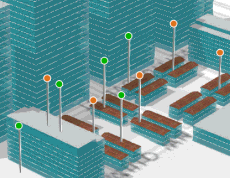require(["esri/symbols/support/Symbol3DVerticalOffset"], (Symbol3DVerticalOffset) => { /* code goes here */ });
import Symbol3DVerticalOffset from "@arcgis/core/symbols/support/Symbol3DVerticalOffset.js";
esri/symbols/support/Symbol3DVerticalOffset
Shifts a symbol along the vertical world axis by a given height. The height is set in screen space units like points or pixels.
Constructors
-
Parameterproperties Objectoptional
See the properties for a list of all the properties that may be passed into the constructor.
Property Overview
| Name | Type | Summary | Class |
|---|---|---|---|
The name of the class. | Accessor | ||
The maximum vertical symbol offset in world units. | Symbol3DVerticalOffset | ||
The minimum vertical symbol offset in world units. | Symbol3DVerticalOffset | ||
Vertical symbol offset in screen size. | Symbol3DVerticalOffset |
Property Details
-
The maximum vertical symbol offset in world units. It acts as an upper bound to avoid vertical offset becoming too big.
In the following animation the green symbols have
maxWorldLength = 50and orange symbols don't havemaxWorldLengthset:
-
minWorldLength
PropertyminWorldLength Number -
The minimum vertical symbol offset in world units. It acts as a lower bound to avoid vertical offset becoming too small.
In the following animation the green symbol on the left has
minWorldLength = 20and for the orange symbol on the rightminWorldLengthhas not been set:
- Default Value:0
-
Vertical symbol offset in screen size. This value may be autocast with a string expressing size in points or pixels (e.g.
12px).- Default Value:0
Method Overview
| Name | Return Type | Summary | Class |
|---|---|---|---|
Adds one or more handles which are to be tied to the lifecycle of the object. | Accessor | ||
Creates a deep clone of the vertical offset. | Symbol3DVerticalOffset | ||
Returns true if a named group of handles exist. | Accessor | ||
Removes a group of handles owned by the object. | Accessor |
Method Details
-
Inherited from Accessor
-
Adds one or more handles which are to be tied to the lifecycle of the object. The handles will be removed when the object is destroyed.
// Manually manage handles const handle = reactiveUtils.when( () => !view.updating, () => { wkidSelect.disabled = false; }, { once: true } ); this.addHandles(handle); // Destroy the object this.destroy();ParametershandleOrHandles WatchHandle|WatchHandle[]Handles marked for removal once the object is destroyed.
groupKey *optionalKey identifying the group to which the handles should be added. All the handles in the group can later be removed with Accessor.removeHandles(). If no key is provided the handles are added to a default group.
-
clone
Methodclone(){Symbol3DVerticalOffset} -
Creates a deep clone of the vertical offset.
ReturnsType Description Symbol3DVerticalOffset A deep clone of the object that invoked this method.
-
hasHandles
InheritedMethodhasHandles(groupKey){Boolean}Inherited from Accessor -
Returns true if a named group of handles exist.
ParametergroupKey *optionalA group key.
ReturnsType Description Boolean Returns trueif a named group of handles exist.Example// Remove a named group of handles if they exist. if (obj.hasHandles("watch-view-updates")) { obj.removeHandles("watch-view-updates"); }
-
Inherited from Accessor
-
Removes a group of handles owned by the object.
ParametergroupKey *optionalA group key or an array or collection of group keys to remove.
Exampleobj.removeHandles(); // removes handles from default group obj.removeHandles("handle-group"); obj.removeHandles("other-handle-group");